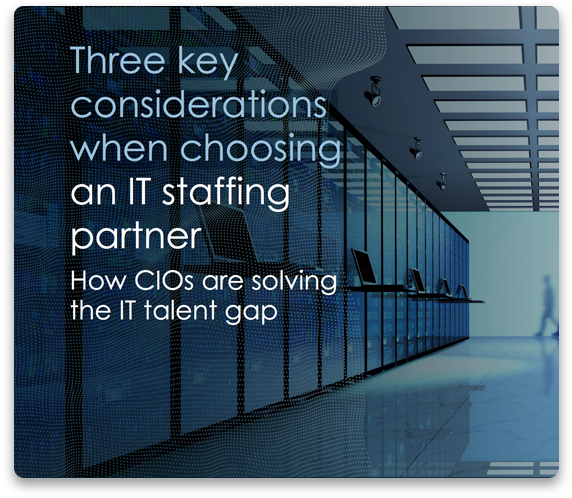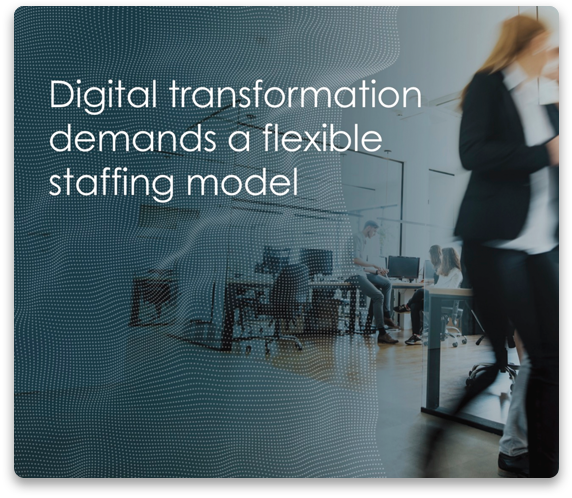TALENT AS A SERVICE
IT Staff Augmentation
Outsourced talent from CBTS can augment your IT team to get your strategic initiatives over the finish line.

IT Staff Augmentation
Benefits
Our approach
CBTS solutions
Case studies
Scale your IT and application teams with experts available 24x7x365
Countless technical projects and IT challenges require expert attention. There simply aren’t enough highly skilled technical professionals to meet the growing demand.
Companies often face fierce competition when trying to access the limited IT talent pool. The good news: IT staff augmentation provides on-demand access to the talent you need to achieve your business and technology goals.
Experts with advanced skills on demand
IT departments are implementing solutions like hybrid cloud, data analytics, artificial intelligence, and the Internet of things to drive innovation with limited budgets, fewer resources, and smaller teams.
The CBTS IT Staffing team deploys highly-vetted, trained, and certified IT specialists to give our clients instant access to people with the advanced skills required to take control.
STAFF AUGMENTATION
What is IT staff augmentation?
Organizations exploring IT project support typically consider two main models: staff augmentation and project outsourcing. Staff augmentation involves hiring temporary workers to fill job positions within the company. CBTS offers consultants for both short and long-term project-based work assisting with the engineering and design of your solution.
Our full-time recruiters work with you to assess your staffing needs and search our extensive database to match you with the right IT talent for both temporary and permanent hires.
BENEFITS
Benefits of IT staff augmentation
Flexible solutions from talented pros
Help your IT department keep pace with the rapid speed of technological advancement.

Flexible solutions
Hire the talent you need when you need it.

Pricing clarity
Pay a predetermined price for a defined time or number of resources.

IT expertise
Get paired with IT pros who can meet challenges unique to your organization.

Resource allocation
Allow an organization’s full-time IT staff to stay focused on your core goals.

Unique perspective
External IT experts see things insiders miss, letting full-timers break out of groupthink.

Deep talent pool
CBTS has over 900 consultants on staff and a database of over 40,000 more.
%
of IT executives believe the ongoing tech talent shortage is the most significant barrier to the adoption of emerging technologies.
Gartner
OUR APPROACH
IT experts when you need them
At CBTS, our goal is simple and client-focused. We strive to keep your IT staff focused on business-critical technology initiatives and to help you create a competitive advantage in the marketplace. Our highly skilled professionals deliver results that meet your growing needs, often with the right to retain and hire.
CBTS provides greater value than traditional staffing companies that don’t have 30 years of experience in the technologies they support. Candidates undergo rigorous pre-qualifications to ensure they have all appropriate training and the required certifications. We provide ongoing support and escalation paths from our resident technical experts throughout the engagement.
Assess skill gaps
Our team evaluates your staffing needs, whether it’s starting a new IT project, finding a subject matter expert, dealing with a staffing shortage, or placing a new hire on the development team.
Matching skill sets
We match our skill sets to your needs, including development, project management, cloud support, ERP/CRM/ECM, database administration, network security, and more.
Tapping our talent pool
In addition to over 100 years of technical recruiting experience, our resource base includes a database of 40,000+ potential contractors and 2,000+ contractors on active engagements.
Flexible delivery
We offer customized solutions for program management, hourly contract resources, contract-to-hire, and direct placement.
Cybersecurity staff augmentation entails collaborating with a technology provider offering on-demand security experts and advisors. At CBTS, our experts are adept at detecting, neutralizing, and eradicating challenging existing and potential threats.

“IT staffing is often a bottleneck for companies trying to evolve by leveraging new technology to address workplace challenges. The difficulties organizations face in hiring full-time IT staff is a business challenge of its own.”
– Bob Hatfield, Director – Consulting Services Sales
CBTS SOLUTIONS
CBTS IT staff augmentation engagement models
Helping organizations bridge the IT talent gap
On-demand developers
Individual technical partner requirements. Examples: UXD architects, DevOps engineers, and QA leads.
On-demand application team
A development team that can scale up and down as required by the needs of a project.
Service-specific team
Fulfills the circumstance where a partner needs a specific service.
Application managed services
The AMS team is a group of developers and system administrators responsible for maintaining, monitoring, and managing applications after they are operationalized.
Dedicated application team
A dedicated development team that works exclusively for a partner. Examples: AMS, QA, and development teams led by SA.
Dig deeper
Case studies

The company is a prominent supplier of uniforms and crucial business amenities, such as janitorial supplies, safety products, fire extinguishers, and safety training courses. The client caters to more than a million enterprises across the United States.
Problem
After a ransomware attack, a third-party security partner advised the client to shut down their virtual desktop network environment, close all inbound and outbound e-mail traffic, and send all office employees home. With its current IT staffing level, the company realized that relaunching its network could take weeks, if not months.
CBTS solution
The client sought CBTS’ assistance a day after the attack to acquire the necessary skilled resources for their IT department to recover. Several teams of CBTS experts covered three different shifts, offering assistance in various areas, such as the virtual server environment (VMware), database servers, and more.
CBTS deployed network architects to determine how to return the virtual environment online. System engineers rebuilt the company’s VMware server environment. The CBTS team also offered assistance in rebuilding all servers and data from backups and implementing testing of all applications and functionality.
Outcome
The client was able to get their virtual desktop network back online within three months of the ransomware attack. Their new network has been rebuilt and modernized with the security needed to address increasing ransomware threats. Thanks to the collaborative efforts of the CBTS team and the client’s IT organization, the company fully recovered from the attack and resumed normal operations.
Align IT staff augmentation with business objectives
The flexibility of staff augmentation enables enhanced alignment with your business objectives. Augmented teams can seamlessly adjust to your project requirements and strategic goals, ensuring that your project advances in harmony with your overarching objectives. Having reliable IT staffing partners can also be a crucial asset for your organization as you aim to stay up-to-date with advancing technologies and systems.
Experienced firms streamline external talent matching for IT support. IT staff augmentation efficiently expands your team to manage your workload.
Forbes
FAQs
Top 5 questions
What is IT staff augmentation?
Staff augmentation refers to temporarily hiring external IT professionals to work with your in-house team, allowing businesses to scale their IT resources as needed without the long-term commitment of hiring full-time staff.
What types of IT professionals can be hired?
A wide range of IT professionals—including developers, analysts, project managers, database administrators, and more—are available for temporary, part-time, or full-time hire.
How is IT staff augmentation different from outsourcing?
Outsourcing involves hiring an external company to handle a specific task or project. IT staff augmentation involves hiring individual IT professionals to work alongside your existing team, allowing you to maintain control over the project.
What are the benefits of IT staff augmentation?
Increased flexibility and scalability, access to specialized expertise, and cost savings compared to hiring full-time staff. Quickly adapt to changing needs and stay up-to-date with the latest technology trends.
How long does IT staff augmentation typically last?
The duration depends on the project or need. Some businesses hire IT professionals for a few weeks or months. Others require services for a year or longer. It’s important to work with a staffing agency that can provide the flexibility to meet your staffing needs.
Related stories
Schedule a complimentary
30-minute consultation with an consultant
Talk to one of our experts today to see how we can help your organization bridge the talent gap with IT staff augmentation.






















